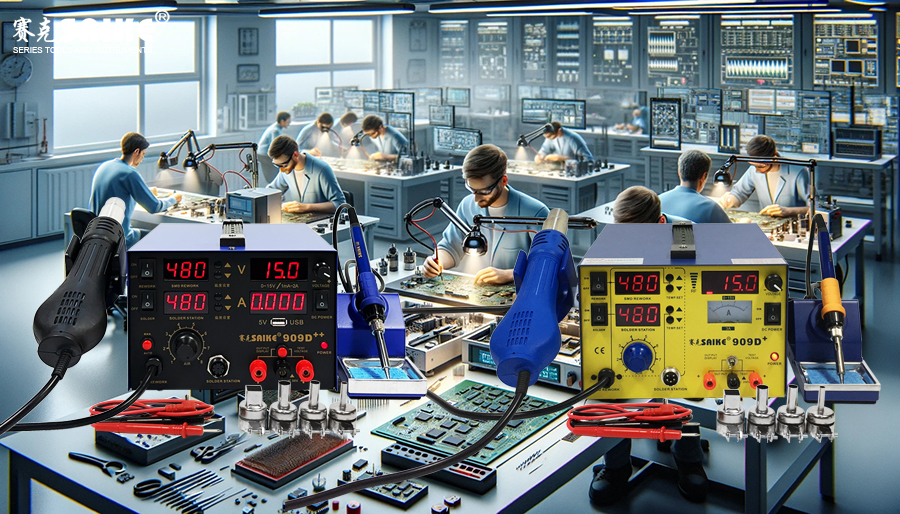
SK-YJ000RFSHY-KP 100027
Soldering is a critical process in electronic manufacturing and repair. Mastering the correct posture and operating procedures for the soldering station not only improves work efficiency but also ensures safe operation and high-quality soldering results. This article will detail the correct posture and operating procedures for the soldering station.
I. Correct Posture
1.Sitting and Standing Posture
– Sitting: Use an ergonomically designed chair, adjust it to a suitable height so that your feet are flat on the ground, and your knees and waist form a 90-degree angle. Keep your arms naturally hanging down, with your elbows parallel to the work surface.
– Standing: Stand with your back straight, feet naturally apart, shoulder-width apart. Adjust the workbench to a slightly lower position than your elbows for comfortable operation.
2.Hand Posture
– Holding the soldering iron: Hold the soldering iron steadily and comfortably, usually adopting a pen-holding posture for better control of delicate soldering operations.
– Supporting the hands: The non-soldering hand can be placed on the workbench to provide stable support and ensure operational stability.
3.Eye Position
– Keep your eyes parallel to the work surface, ensuring that your line of sight is perpendicular to the soldering point. This avoids soldering errors or eye damage due to angular issues.
II. Preparation and Inspection of the Soldering Station
1.Equipment Inspection
– Power inspection: Ensure that the soldering station’s power cord and plug are undamaged, tightly connected, and the power supply is normal.
– Temperature setting: Set the appropriate temperature based on the soldering material and solder requirements. The soldering temperature for general electronic components is around 350℃.
2.Tool Preparation
– Prepare soldering wire, flux, solder sucker, tweezers, and other auxiliary tools.
– Check if the soldering iron tip is clean. If there is oxide, clean it with a cleaning sponge or soldering wire.
III. Operating Procedures
1.Heating and Cleaning
– Turn on the soldering station power and wait for the soldering iron tip to heat up to the set temperature.
– Use a wet cleaning sponge to clean the soldering iron tip, ensuring it is free of oxides and impurities.
2.Soldering Preparation
– Apply a suitable amount of flux to the area that needs soldering to improve soldering results.
– Position the soldering wire close to the soldering point, preparing for soldering.
3.Soldering Operation
– Heating the soldering point: Gently touch the soldering iron tip to the soldering point, heating it for 2-3 seconds to reach a suitable temperature.
– Adding solder: Bring the soldering wire close to the heated soldering point, and the solder will quickly melt and flow into the soldering point.
– Removing the soldering iron: After the solder has fully melted, remove the soldering wire and then quickly remove the soldering iron tip to keep the soldering point neat and smooth.
4.Inspection and Cleaning
– Check if the soldering point is secure and if the solder evenly covers the entire soldering point.
– Use a solder sucker to clean up excess solder, ensuring there are no solder bridges or short circuits at the soldering point.
IV. Maintenance After Operation
1.Power Off
– After completing the soldering operation, turn off the soldering station power and wait for the soldering iron tip to cool down.
– Ensure all equipment power is turned off to avoid potential safety hazards caused by prolonged power-on.
2.Cleaning Tools
– Clean the soldering iron tip and other tools to prevent residual solder and flux from affecting future use.
– Organize the tools neatly and keep the workbench clean and tidy.
V. Safety Precautions
1.Preventing Burns
– Avoid direct contact with the soldering iron tip and high-temperature soldering areas during operation.
– Use heat-resistant gloves and protective eyewear to prevent accidental burns and solder splashes.
2.Ventilation and Protection
– Ensure good ventilation in the working environment and use exhaust devices to prevent inhalation of harmful soldering fumes.
– Regularly replace the filter element of the exhaust device to ensure its effectiveness.
VI. Summary
Correct posture and operating procedures are crucial for smooth soldering work. By maintaining good sitting or standing posture, mastering soldering operating procedures, and focusing on post-operation maintenance and safety precautions, soldering quality and work efficiency can be improved while effectively avoiding various safety hazards. Soldering personnel should continuously learn and optimize operation skills to ensure the best results for every soldering job.


